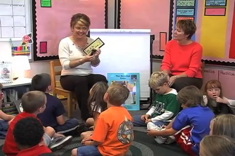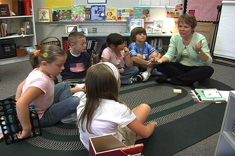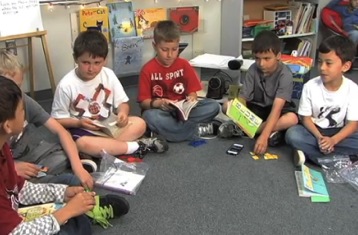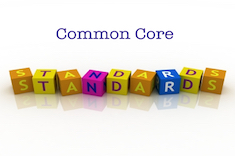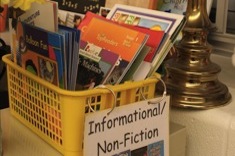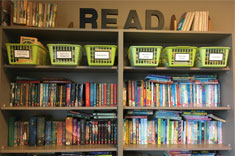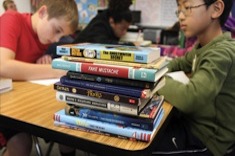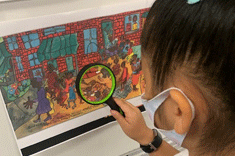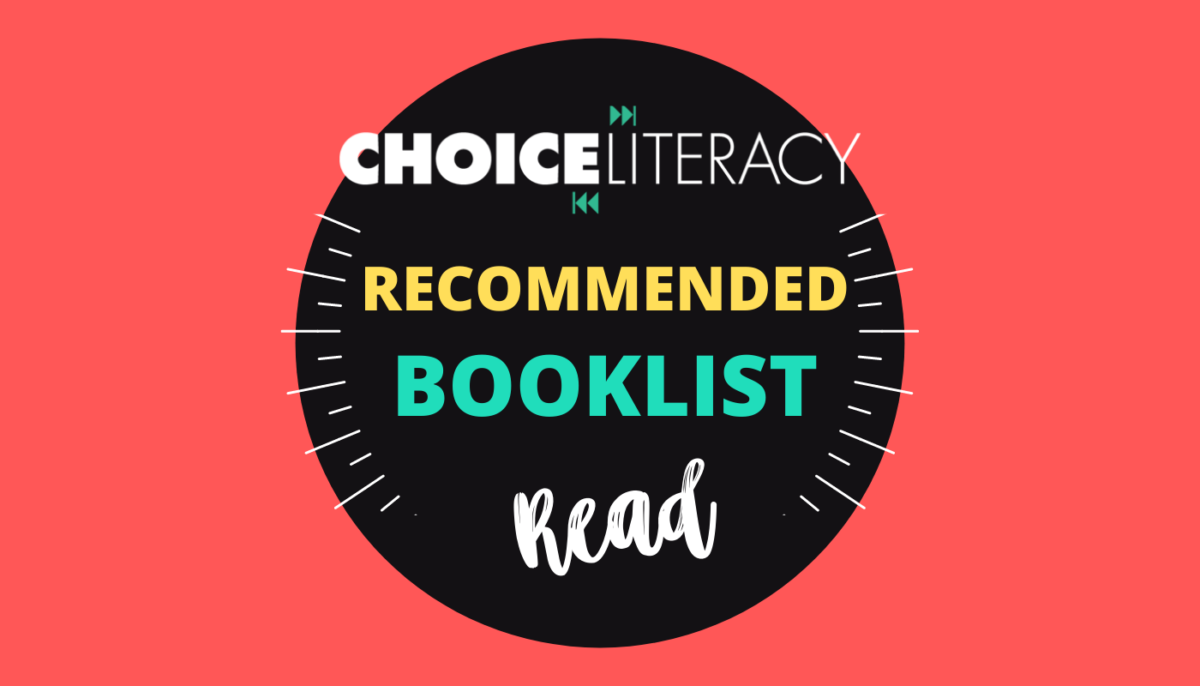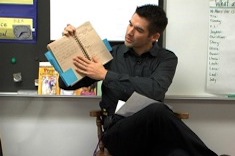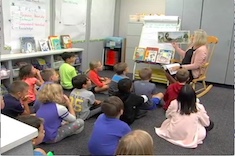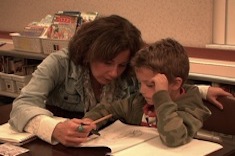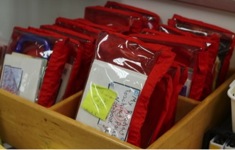2nd
Latest Content
Small Group Instruction: Inferring Focus
In this example of reading instruction with a small group, Gail Boushey of “The Sisters” leads a discussion of inference, using Peter Rabbit as a focus text. All of the children in the group are reading at different levels independently, but they share a goal of learning more about inferring.
Whole-Class Vocabulary Lesson, Grades K-2
In this five-minute video, Joan Moser of “The Sisters” teaches a whole-class vocabulary lesson. The focus is on helping students notice interesting words, and make connections between daily read-alouds and word learning.
Noticing Interesting Words: Small-Group Vocabulary Lesson
In this five-minute video, Gail Boushey leads a short small-group lesson on vocabulary.
Community Language Board: Building Vocabulary All Year Long
“The Sisters” (Gail Boushey and Joan Moser) talk about how the community language board changes and evolves over the year, building a sense of community and shared literacy.
Listen In: Jeffry’s Ocean Story
Moving a child from simple to complex sentences is the goal in this second-grade writing conference.
Boys’ Book Club in Second Grade
In this video from Linda Karamatic’s second-grade classroom, boys discuss the book Fudge using the protocol provided by Linda.
Common Core Conversations: Increasing Argumentative Writing
Teachers continue to puzzle over and sort through the terminology in the Common Core related to opinion and persuasive writing. Amanda Adrian and Heather Rader consider terms and teaching strategies.
“I Am the Book”: Helping Emergent Bilingual Learners Connect with Books
Jesabel Centeno helps her emergent bilingual learners respond orally to texts and share favorite books with classmates.
Gratitude Week
Gigi McAllister shares the tradition of Gratitude Week. It gives students an authentic writing experience that has a ripple effect of spreading joy and gratitude throughout the school. It also shows them the significant impact that their words can have on others.
Conferring on Inferring in Second Grade
Linda Karamatic works with a student who is reading the Stink series as he tries out a new tool for documenting inferences as he reads.
Use Math Practices to Deepen Friendships
Molly James is inspired by the book Friends Beyond Measure to use math practices to strengthen the bonds of friendship in her kindergarten classroom.
Going Deeper with Math Curricular Materials
Mallory Messenger guides us in taking what our district-adopted math curriculum resources provide and planning small changes by using problem stems and student problem posing to increase the rigor and make mathematical experiences accessible for all students.
Searching for Patterns with First Graders
Mallory Messenger leads us through a process to help first-grade students discover patterns by leaving the middle of an equation open. Mallory offers resources and student work to help every teacher see the possibility of giving students opportunities to make sense of math.
Writing as an Act of Resistance and a Source of Strength
In this beautiful personal essay, Stella Villalba reminds us that writing is a source of strength, and developing a community of writers is essential in post-pandemic classrooms.
Book Matchmaker: Read Alouds That Invite Young Readers to Participate
Franki Sibberson shares her latest suggestions for read alouds that invite participation from young readers.
Launching a Classroom Library
Melissa Styger slows down the launch of the classroom library to ensure it is a valuable resource all year.
Field Experience: Supporting Independent Reading, Choice and Stamina
Helping students learn to choose books and develop stamina are important to developing independent readers. Ruth Ayres designed a field experience with opportunities to see minilessons, small group instruction, team meetings and a share session that support independence in readers.
Trusting the Letting-Go Moments
Mandy Robek writes a powerful essay about giving her students more decision-making power in sharing their learning. In the release of letting go, she found ease in the joy of learning.
Nonfiction Books for Compassion, Inspiration, and Heart
Mandy Robek set out on a quest to discover new nonfiction books with characters who offer inspiration, compassion, and heart. Here are eight new titles you won’t want to miss.
Books That Sustain the Linguistic Lives of Multilingual Learners
We need more bilingual books! Stella Villalba explains why these books are essential and provides a booklist to help sustain the linguistic lives of multilingual learners.
Picture Books for Naming Emotions
Mandy Robek continues her series on picture books for understanding emotional turmoil in students. In this installment, she shares a list of books that can help children name emotions.
Finding Topics in Writer’s Notebooks Minilesson
Sean Moore shares the importance of using a writer’s notebook to discover topics in this minilesson with his second-grade students from early in the year.
Integrating Vocabulary and Retelling Strategies into Read-Aloud
Stella Villalba scaffolds the language development of her first- and second-grade English language learners during read-aloud by highlighting vocabulary and providing a tool to assist with a partner retelling activity.
In-the-Moment Word Study
We would all agree that there is a place for structured phonemic awareness and phonics lessons in the school day, and there is a place for language play and fun! Bitsy Parks shares some of her favorite in-the-moment, highly engaging word study experiences in her first-grade classroom.
Using Whiteboards Before Writer’s Notebooks
Jen Court shares the way whiteboards and conversation lifted pressure from student writers so they could create poetry.
Author Studies for Primary Students
Jen Court shares the benefits of an author or illustrator study and offers tips for getting started in primary grades.
Instructional Routines That Promote Agency for Multilingual Learners
Cultivating agency is a matter of building small, intentional moves that ask students to be part of the learning process. Stella Villalba offers three ways educators can support the growth of multilingual learners in all learning spaces.
Field Experience: Kindergarten Writers
Spend time with the youngest writers and you will be mesmerized by their writing processes. Ruth Ayres assembled a field experience focused on kindergarten writers.
Organizing Materials to Support Literacy Learning (Classroom Design Series Part 3)
Ann Marie Corgill shares how she organizes materials for literacy learning in the third installment of her design series.
Inside and Outside Views Minilesson
Ruth Ayres leads a minilesson in second grade on inside/outside views — what’s happening objectively (on the outside) vs. emotions (on the inside). The terms are a good starting point for helping young students distinguish between facts and opinions.
Browse Content By
Type
Category
- Assessment Tools
- Big Fresh Archives
- Booklists
- Choice Numeracy
- Classroom Design
- Common Core
- Community Building
- Conferring
- Content Literacy
- Digital Literacy
- English Language Learners
- Equity
- Family Relations
- Free Samples
- Guiding Groups
- Leadership
- Literacy Coaches
- Mentor Texts
- Minilessons
- New Teacher Mentors
- Podcasts
- Poetry
- Quote Collections
- Reading Strategies
- Self Care
- Struggling and Striving Learners
- Talking and Listening
- Teacher Study Groups
- Teaching Reading
- Teaching Writing
- Word Study and Vocabulary
Author
- Melissa Quimby
- Nawal Qarooni
- Gwen Blumberg
- Julie Cox
- The Lead Learners
- Hannah Tills
- Josie Stewart
- Ruth Metcalfe
- Mallory Messenger
- Becca Burk
- Jodie Bailey
- Vivian Chen
- Mary Brower
- Tiffany Abbott Fuller
- Stephanie Affinito
- Ruth Ayres
- Leigh Anne Eck
- Heather Fisher
- Shari Frost
- Julie Johnson
- Suzy Kaback
- Gigi McAllister
- Shirl McPhillips
- Melanie Meehan
- Cathy Mere
- Debbie Miller
- Tara Barnett and Kate Mills
- Tammy Mulligan
- Dana Murphy
- Bitsy Parks
- David Pittman
- Brenda Power
- Heather Rader
- Matt Renwick
- Mandy Robek
- Christy Rush-Levine
- Gretchen Schroeder
- Jen Schwanke
- Brian Sepe
- Katherine Sokolowski
- Stella Villalba
- Jennifer Vincent
Grade Level
Choice Literacy Membership
Articles
Get full access to all Choice Literacy article content
Videos
Get full access to all Choice Literacy video content
Courses
Access Choice Literacy course curriculum and training


